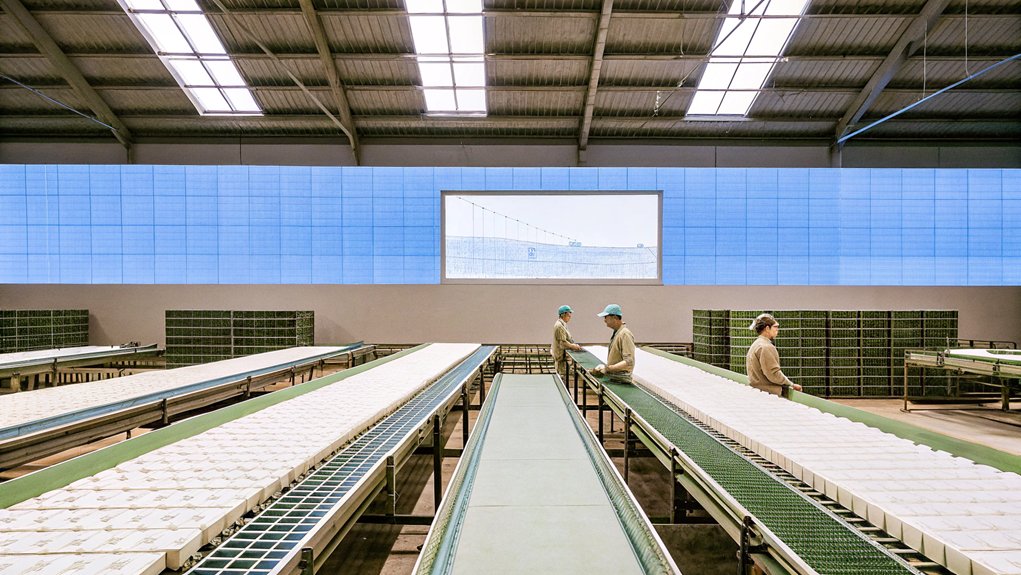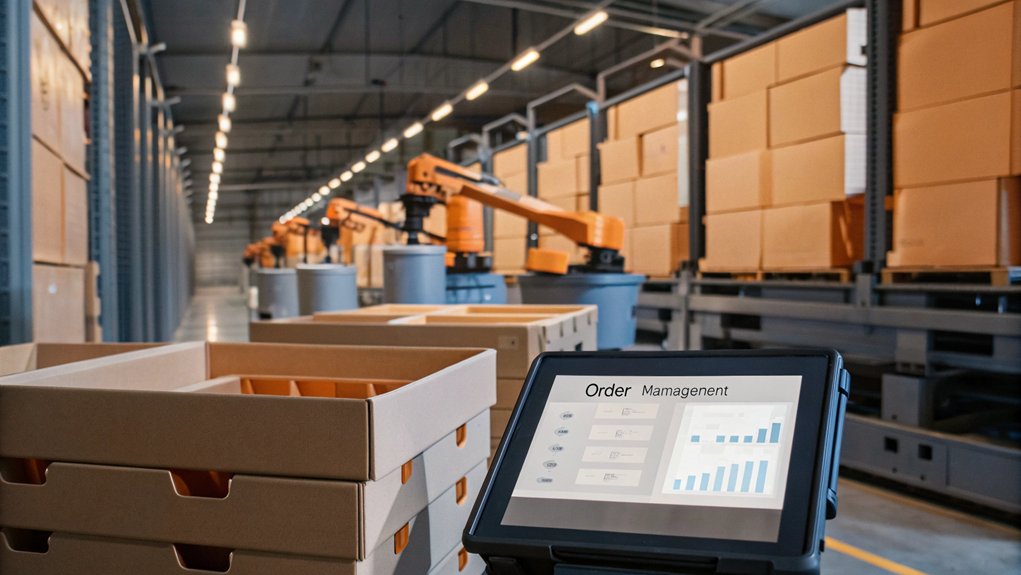Scaling Production: Managing Orders of Any Size
Consider a manufacturer like Tesla, which adjusts production rates based on fluctuating demand for their vehicles. To effectively scale production, you need to manage orders of varying sizes while maintaining efficiency. This requires a strategic approach that incorporates advanced automation, just-in-time inventory, and a workforce that's adaptable. The question is, how do you implement these strategies to guarantee your operations can respond to market changes without compromising quality or increasing costs?
Key Takeaways
- Implement flexible manufacturing equipment to quickly adapt to changing order sizes and fluctuations in demand.
- Utilize advanced automation systems for efficient order processing and integration with existing production workflows.
- Foster strong supplier partnerships to ensure a reliable flow of materials, minimizing disruptions in production.
- Leverage modular production lines to scale operations without significant restructuring during order surges.
- Monitor performance metrics and adjust resource allocation dynamically to meet varying order requirements effectively.
Understanding Scaling Manufacturing
As you consider scaling your manufacturing operations, it's vital to recognize that effective growth hinges on a thorough understanding of your current capabilities and potential bottlenecks.
Start by evaluating your production capabilities to meet increasing demands, focusing on asset utilization and throughput. Strategic planning plays an important role in this process; set measurable objectives and leverage data-driven approaches for resource allocation.
Evaluate your production capabilities with a focus on asset utilization and throughput to effectively meet growing demands.
You'll want to identify bottlenecks that could hinder efficiency and develop robust inventory management practices. Quality control measures must remain a priority to guarantee product consistency as you scale.
Addressing challenges like space constraints and resource allocation complexities will pave the way for successful, scalable production and foster a resilient operation that meets your customers' needs.
Key Components of Scalable Production

To achieve scalable production, you must prioritize several key components that enhance your operational efficiency and adaptability.
Focus on the following aspects to effectively meet customer demands:
- Flexible manufacturing equipment to adapt to fluctuating demand
- Advanced automation systems that integrate seamlessly with existing processes
- Supply chain resilience to guarantee a steady flow of materials
- Modular production lines for targeted scaling without major overhauls
- Strategic partnerships with suppliers to enhance production flow
Common Challenges in Scaling Manufacturing Operations

As you scale your manufacturing operations, you'll encounter significant challenges that can impede growth.
Space limitations require you to optimize layouts, while increasing production volumes complicate resource allocation and scheduling.
Additionally, maintaining quality control becomes vital to prevent defects, making it essential to strategize effectively in these areas.
Space Limitations and Optimization
While scaling manufacturing operations offers exciting growth opportunities, space limitations often present significant challenges that can hinder efficiency and productivity.
To navigate these constraints effectively, consider the following strategies:
- Optimize factory layouts for better material flow
- Implement modular production lines for targeted scaling
- Utilize vertical space to maximize storage and production
- Conduct regular assessments of space usage
- Adjust operations based on evolving production needs
Resource Allocation Complexity
Scaling manufacturing operations introduces a myriad of challenges, with resource allocation complexity standing out as a prominent issue. You need effective scheduling and real-time monitoring to avoid bottlenecks and optimize machinery and labor utilization. Accurate demand forecasting becomes critical; mismanagement can lead to overproduction or stockouts.
Here's a breakdown of common resource allocation challenges:
| Challenge | Impact on Operations | Mitigation Strategy |
|---|---|---|
| Communication Gaps | Inefficiencies in processes | Implement integrated systems |
| Raw Material Procurement | Disruptions in production flow | Build strategic partnerships |
| Quality Standards | Compromised output quality | Establish robust quality checks |
Balancing raw materials, labor, and equipment is essential for maintaining production flow while adhering to quality standards. Embracing flexible supply chain management can further enhance your resource allocation strategies.
Quality Control Challenges
Quality control becomes increasingly complex when production volumes rise, demanding a strategic approach to manage the heightened risk of defects.
As you scale operations, consider these challenges:
- Increased defect rates, potentially rising by 30%
- Variability in processes and materials affecting consistency
- The need for more quality assurance personnel
- Integration of advanced inspection technologies
- Lapses in adherence to quality standards
To effectively navigate these challenges, invest in automated scheduling and real-time monitoring systems.
These technologies enhance your manufacturing process, ensuring that quality control remains robust even as production capacity expands.
Assessing Current Manufacturing Capabilities

To effectively assess your current manufacturing capabilities, start by evaluating production capacity effectiveness and identifying any bottlenecks that could hinder scaling.
Analyzing metrics like asset utilization and throughput will reveal critical areas for improvement that directly impact your ability to increase output.
Evaluating Production Capacity Effectiveness
When evaluating production capacity effectiveness, it's critical to analyze key metrics like asset utilization and throughput to pinpoint areas for improvement.
This assessment helps guarantee your manufacturing capabilities can meet increased demands without sacrificing quality.
Consider the following factors:
- Asset utilization rates
- Throughput levels
- Maintenance downtime
- Quality control metrics
- Automation efficiency
Identifying Bottlenecks for Scaling
Identifying bottlenecks for scaling your production process requires a meticulous examination of your current manufacturing capabilities.
Start by analyzing key metrics like asset utilization and throughput to locate underperforming areas. Regular maintenance tracking is vital; unplanned downtime can derail your scaling efforts and inflate costs.
Plus, effective quality control monitoring helps spot patterns in product defects that may signal bottlenecks on the production line. By leveraging modular production lines, you can isolate specific processes, making it easier to tackle issues without disrupting overall operations.
Addressing these bottlenecks before scaling is critical; if left unresolved, they can hinder your production volume and compromise product quality as demand increases.
Take action now to guarantee a smoother scaling journey.
Strategic Planning for Scale

Strategic planning for scale requires a proactive approach to setting clear objectives and measurable production targets that align with your business growth aspirations.
To effectively manage orders of any size, focus on:
- Identifying critical expansion points within your production capacity
- Allocating resources efficiently for ideal output
- Leveraging data analysis to make informed scaling decisions
- Regularly evaluating progress using key performance indicators (KPIs)
- Emphasizing automation to enhance operational efficiency
Digital Transformation and Automation Solutions

As digital transformation reshapes the manufacturing landscape, it's crucial to embrace advanced technologies that foster real-time insights and operational efficiencies.
By integrating automation solutions like robotics and automated guided vehicles, you can streamline your production processes, greatly reducing costs by up to 20%.
Smart manufacturing systems leverage real-time data analytics to dynamically adjust parameters, ensuring quality while responding to demand fluctuations.
Predictive analytics allows you to harness historical data for accurate demand forecasts, optimizing resource allocation and cutting excess inventory by up to 30%.
Cloud-based platforms enhance effective communication and facilitate seamless integration of operational processes, providing scalability and flexibility in managing orders.
Embracing these innovations positions you to thrive in a rapidly evolving manufacturing environment.
Optimizing Operations for Growth

To optimize operations for growth, you must focus on implementing practices that enhance efficiency and reduce costs.
By prioritizing strategies like:
- Just-in-time inventory management to cut carrying costs
- Regular KPI reviews to pinpoint improvement areas
- Cross-training programs for a versatile workforce
- Advanced automation to decrease downtime
- Data-driven decision-making for better resource allocation
you can markedly boost your production capacity.
Emphasizing continuous improvement initiatives allows you to refine your manufacturing processes, ensuring you stay agile and competitive.
Embracing continuous improvement fosters agility in manufacturing, keeping your business competitive in a rapidly evolving market.
Leveraging technology not only streamlines workflows but also enhances overall productivity.
As you navigate these changes, you'll foster a culture of belonging, where every team member feels empowered to contribute to the company's growth.
Measuring and Analyzing

While effective operations management hinges on optimizing processes, accurately measuring and analyzing performance is equally essential.
You need to track key performance indicators (KPIs) like order fulfillment rates and production cycle times to evaluate your scaling initiatives. By analyzing this data, you can gain insights into resource allocation and process efficiencies, helping you make informed decisions.
Regularly reviewing performance metrics, including equipment effectiveness, will highlight areas for improvement. In addition, evaluating the return on investment (ROI) for these initiatives guarantees effective resource allocation aligns with your financial goals.
Implementing real-time monitoring systems enhances visibility into production order status, allowing you to make quicker adjustments and optimizations in response to shifting demands, ensuring that your operations thrive together.
Workforce Development and Training

Effective workforce development and training play a pivotal role in scaling production, ensuring your team is equipped to meet evolving demands. By investing in training programs, you can boost productivity by up to 25% and reduce employee turnover by 30%.
Key strategies include:
- Cross-training for operational flexibility
- Continuous learning initiatives like workshops and online courses
- Enhanced quality control to reduce defects by 20%
- Establishing mentorship programs for knowledge transfer
- Fostering a culture of adaptability and collaboration
These elements not only improve employee skills but also create a cohesive environment where everyone feels valued.
As you prioritize workforce development, you'll cultivate a skilled, engaged team capable of maneuvering through the complexities of scaling production efficiently.
Frequently Asked Questions
What Is Scaling in Production?
Scaling in production means enhancing your production capacity to meet fluctuating demand while focusing on efficiency optimization.
You'll need to implement effective demand forecasting to align resource allocation and workforce management.
By integrating technology, you can streamline operations and achieve cost reduction without sacrificing quality control.
A resilient supply chain supports this process, ensuring you maintain consistent output.
Ultimately, scaling allows you to adapt swiftly and effectively to market demands, fostering growth and stability.
What Is Scaling in Product Management?
Scaling in product management involves strategically steering the product lifecycle by utilizing demand forecasting and market analysis.
You'll need to focus on effective resource allocation and risk management while ensuring team collaboration.
Technology integration plays an essential role in enhancing quality assurance processes.
How Do You Scale Manufacturing?
To scale manufacturing effectively, you need to focus on production efficiency and capacity planning.
Evaluate your supply chain for bottlenecks and implement technology integration to streamline processes.
Prioritize lean manufacturing principles for cost reduction while ensuring quality control.
Optimize your inventory levels to meet demand without overstocking.
Invest in workforce management to enhance employee productivity, and regularly assess metrics to maintain operational excellence as you scale your operations.
What Is the Scale-Up Process in Manufacturing?
Imagine trying to fit a square peg in a round hole—this is what scaling up in manufacturing can feel like without the right approach.
You'll need to assess your production capacity and implement scale-up strategies that enhance operational efficiency.
Focus on resource allocation, quality control, and workforce training.
Embrace automation technologies for smooth supply chain management, and prioritize cost management to guarantee your scaling efforts are sustainable and aligned with your business goals.
Conclusion
In today's fast-paced market, scaling production isn't just beneficial; it's essential. By implementing advanced automation and just-in-time inventory management, you can position your operations to meet any order size efficiently. Are you ready to embrace the strategic planning and workforce development necessary to enhance your production capabilities? With the right tools and mindset, you can navigate the complexities of demand fluctuations and drive your business toward sustainable growth and success.